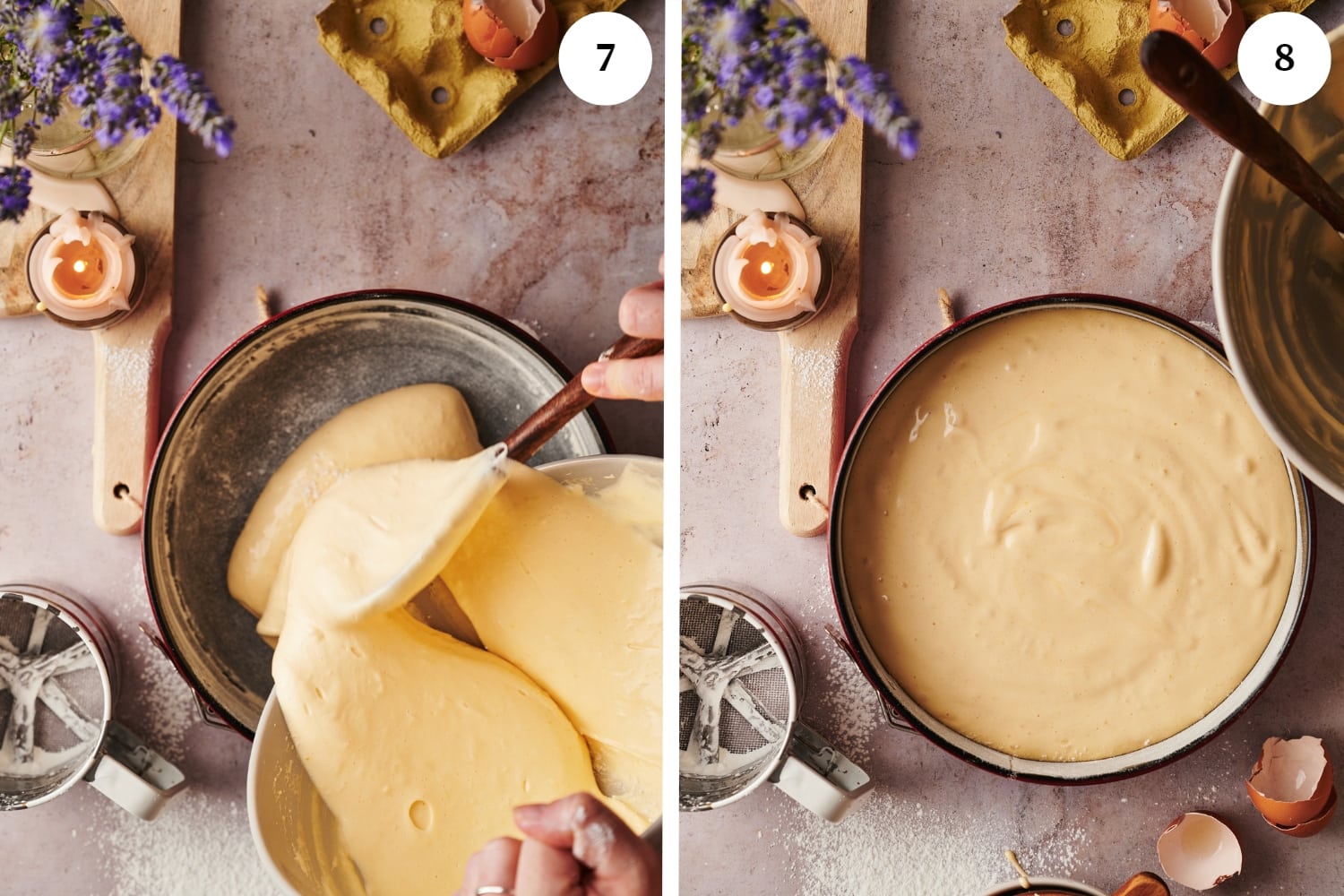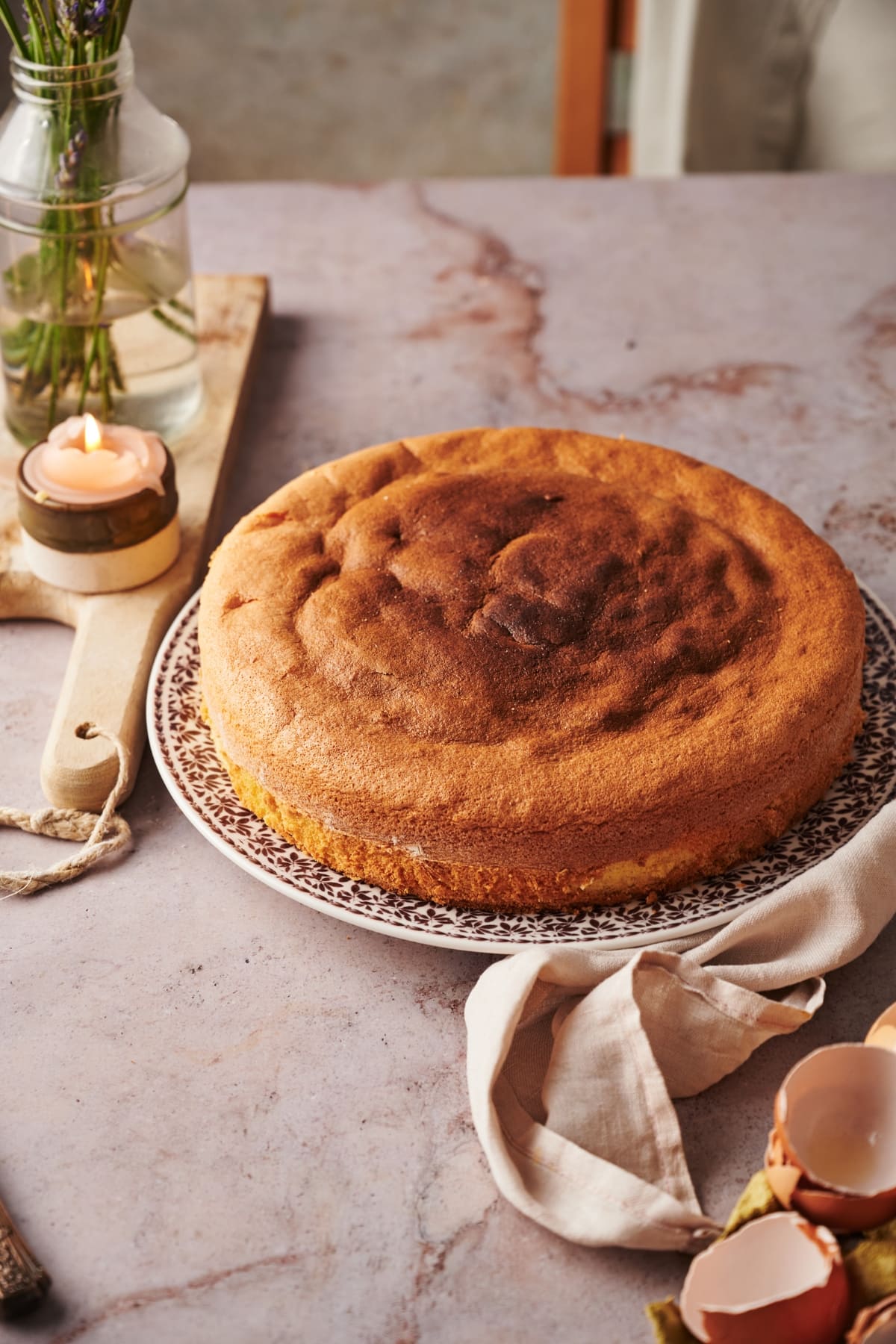Italian sponge cake, pan di spagna, is a simple cake recipe that can be used as a neutral base to create all kinds of fantastic layer cakes filled with delicious fillings such as chocolate or vanilla pastry cream, mascarpone cream, Nutella, or even soaked in a bit of rum to make a rum cake. A fun and fancy Italian dessert that calls for either sponge cake or lady fingers is Zuppa Inglese.

This is my nonna’s sponge cake recipe, so add this dessert basic of Italian baking to your repertoire today! The perfect cake for your next birthday party or dessert after Sunday lunch. And be sure to get creative with your favorite additions to make this pan di spagna sponge cake extra special.
With no need to sit and rise, you can make this recipe from start to finished cake in under one hour! This easy recipe makes a pan di spagna cake that will remain soft and moist.

Preheat: Preheat the oven to 350° F | 180° C.
Beat the egg batter: Put all the eggs and sugar, lemon zest, pinch of salt, and vanilla extract together in a stand mixer or electric mixer with a large bowl (photo 1) and whisk together on medium-high speed and then at the highest speed for about 10 minutes (photo 2). The mixture should quadruple in volume and be frothy although fairly dense (photo 3).

Sift and fold in the flour and starch: Sift the flour and the potato starch through a sieve into a bowl and mix together (photo 4).

Now add a third of the sifted flour and starch mixture into the beaten eggs (photo 5) and fold in with a spatula or wooden spoon carefully, without deflating the mixture (photo 6). Add another third and repeat and then the final third and repeat.

Coat your cake pan and fill: Coat your 9-in | 22-cm round spring-form baking pan with butter and then with a little flour to cover the bottom and sides. Gently pour in the cake batter evenly into the prepared cake pan (photo 7).

Bake the Italian sponge cake: Place in the preheated oven on the middle rack and bake for approximately 35 minutes, without opening the oven door for at least 30 minutes. A light golden crust should form on the top and the inside should be pale yellow with a spongy texture. A toothpick should come out clean when it is ready.

Let it cool: After removing from the oven, let it cool for 15 minutes in the pan and then cut around the edges with a knife (photo 9), open the springform cake pan, and remove the cake. Place it on a wire rack or parchment paper and let cool completely (photo 10).

Authentic Italian recipes that use sponge cake:
Enjoy your sponge cake with one of these Italian drinks:
If you have just the pan di spagna and no filling, you can store it in an airtight container or in plastic wrap for up to 3 days at room temperature. If, instead, you have used your pan di spagna to make a cake that is filled, you will need to keep it in an airtight container in the fridge and it should stay good for up to 48 hours, but beware that some fillings will become wet and runny and can spoil the cake quickly or make it too soggy to keep.
Yes, wrap the cool pan di spagna in plastic wrap or place is a freezer bag and freeze for up to one month. To use, defrost in the fridge overnight and use while still cool.
There are several types of sponge cake, one is genoise sponge cake, which is very similar to pan di spagna except that the ingredients are heated. Another is is chiffon cake which is more moist because it has oil in it and also some baking powder to make it rise. And yet another is angel food cake make with only the egg whites and with the addition of baking powder, it comes out very tall and spongy and white.
The main difference between sponge cake and regular cake recipes is that sponge cake uses a lot of eggs and beats lots of air into the batter to create an airy, light yellow cake. Regular cake recipes usually use less eggs, more flour and butter or oil and a leavening agent to make the cake rise.
Genoise and sponge cake have the same basic ingredients, the main difference is that the genoise cake is made with hot ingredients and the sponge cake is made with room temperature or cool ingredients. The final result is very similar.

Legend has it that Italian sponge cake, the cake called pan to spagna which translates literally into “bread of Spain” can be traced back to an Italian chef from Genoa named Cabona who was working for the Ambassador from Genoa at the royal court in Spain when he made this simple, airy golden cake and delighted the court! His sweet treat was nicknamed “genoise” because he was from Genoa. The term genoise still exists for a more complicated version of the cake, but this more simple version with room temp or cold ingredients was eventually given the name pan di spagna.